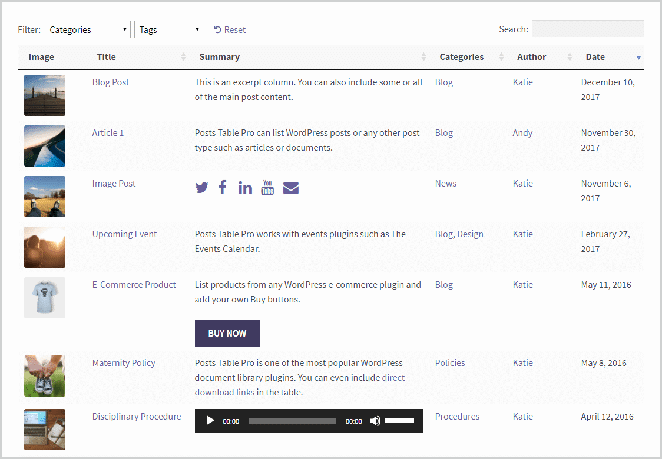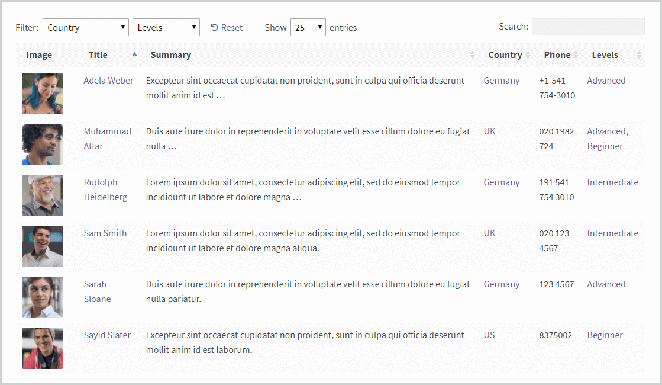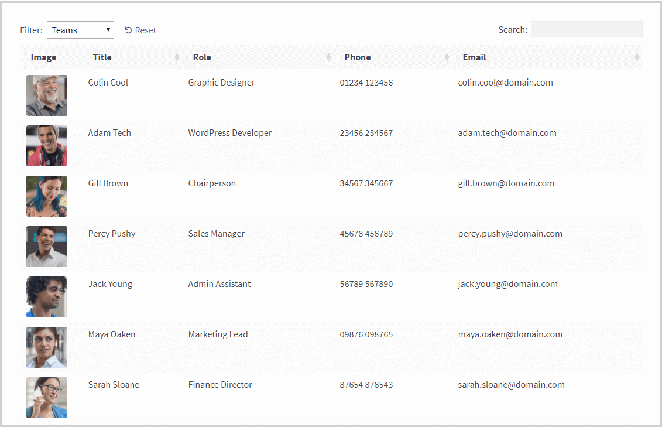
3 Ways Dynamic Tables can Improve your WordPress Site
In the past, most sites focused on static content. These days, dynamic content rules the web. Internet users expect to be able to interact with most of the content they view, to some extent or another.
Adding dynamic elements to your site—such as searchable and sortable tables—is a smart way to improve the user experience. This kind of “WordPress posts table” helps visitors find what they’re looking for quickly, and presents your content in the best possible light.

In this article, we’ll explain what dynamic tables are. Then we’ll talk about some of the ways they can be used effectively on your WordPress site. Let’s get started!
An Introduction to Dynamic WordPress Tables
WordPress provides a lot of handy functionality. Still, there are some things it’s not very good at out of the box. One of those is providing ways to organize your content in a dynamic way, and another is setting up tables.
When we talk about dynamic tables, we’re referring to something like this:

Here, you can see a list of a website’s content, including some blog posts, images, events, and so on. As with any table, this is an organized and attractive way to present information on your site. This particular table is dynamic, however, because it doesn’t merely present static information.
Instead, users can search through the table to find what they need quickly. They can use the search function, sort through various categories and tags via the drop-down menus, and even click on each column’s heading to reorganize the table itself.
There are a lot of applications for this kind of table. The example above includes a variety of items, but most often you’ll use a ‘posts table’ to display a specific type of content. (Despite the name, this is not just limited to posts). Below, we’ll look at a few of the top use cases.
Of course, you may be wondering how you can add this kind of table to your site. While it would be possible to achieve this effect using some custom code, it would take a lot of work. A simpler solution is to use a dedicated plugin, such as Posts Table Pro. This will enable you to add fully-customizable tables to your WordPress site, and then tweak their appearance, behavior, and contents to meet your exact needs.
Three Ways Dynamic Tables can Improve Your WordPress Site

Right now, all of this may still feel a bit abstract. Therefore, let’s look at a few examples of dynamic WordPress tables in action. What follows are three ways you can use a posts table to organize your content in a more compelling and user-friendly way.
1. You can Create a Library of Media Files
Your WordPress site has a Media Library that’s just for your use. This is a handy feature for when you’re creating and updating content. However, you may also want to display a selection of media files for your website’s audience.
For example, you could collect your best YouTube videos, and show them off on a single page. The same applies to audio files—this comes in handy if you run a podcast. Either way, you can display only the files you want in your dynamic table, include whatever information you like about each one, and even embed the files themselves directly.
Let’s see how this might work in action. First up, an audio gallery:

Here you can see a list of audio files, each of which can be listened to right from the table. There’s some basic information included about each one as well, such as its title and description. Users can also filter the table by genre and search for specific files using the field above the table.
Now, a video gallery:

Again, visitors can watch each video within the table, or they can click on any title to visit that video’s dedicated page. These videos are separated into various topics, which people can use to filter the files.
Overall, this is a more attractive and useful way of displaying a lot of media files than trying to embed each one separately in a page or post. The best part is that the tables pictured above are only examples—you can arrange yours however you like and include more or less information about each piece of media.
2. They can Help you Display a Membership Directory
A lot of WordPress sites enable some sort of registration and/or membership. If you’re running this type of site, it can be a good idea to display information about all your members in a single location.
This way, if someone needs to get in touch with a particular member, they can find the information they need easily (such as contact details). Showing off a list of your user base can also be a great way to prove to new visitors how much reach your company or organization has.
As you can probably guess, a dynamic table is the perfect way to do this. Let’s look at an example:

This directory lists each member’s name provides a summary about them, and even shows a profile picture for a more human touch. There are also a few details about how to contact each member, and what level of expertise they have.
If displayed on the front end of your site, visitors can use this directory to browse through your members list. They can also filter the list by whatever criteria you like, in order to locate someone they want to get in touch with. You could make this table publicly viewable by anyone, or lock it away in a safe, members-only area.
It’s worth noting that the same kind of table can be used within a company or organization as well. Instead of a members list, you can create a staff directory:

This helps ensure that all employees have access to the information they need, and can be used effectively on an internal company site. Again, you can add just about any details you like to this directory, so you’re only focusing on what matters to your particular organization.
3. You’re Able to put Together a Document Library
Some sites need to provide a lot of documents to their users. This could include forms, legal information and policies, white papers, ebooks, or just about anything else. If you want these items to be useful to your audience, you’ll need to make them simple to locate and download (or view).
Once again, a dynamic table can come to the rescue:

Here you can see the name of each document, a summary about it, and a few other pertinent details (such as the year it was created and its file type). You can also include an image of each document, and any additional details you like.
What’s most important about this table is the very last column. There, users will find embedded buttons enabling them to download and/or view each document quickly. This saves them the trouble of having to navigate to the documents’ individual pages. Plus, as before, they can search, sort, and filter the table to quickly locate the exact items they need.
Conclusion
If you have a lot of similar content on your WordPress site, it’s worth putting some serious thought into how that content is displayed. An organized, searchable, and customizable table can be the perfect way to show off your content in the best possible light, and make it all easy to access.
The sky’s the limit when it comes to using dynamic tables on your site, particularly if you’re using a flexible plugin such as Posts Table Pro to create them. Among many other use cases, you can:
- Create a library of media files.
- Display a membership (or staff) directory.
- Put together a document library.











